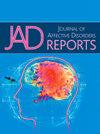Atypical automatic processing of interoceptive information in adolescents with alexithymia
Q3 Psychology
引用次数: 0
Abstract
Background
Alexithymia, characterized by impaired emotional identification and expression, exhibits conceptual and neuroanatomical overlap with atypical interoception - the ability to perceive and process bodily signals. This study investigates in adolescents the link between alexithymia and interoception using the heartbeat-evoked potential (HEP), a brain response reflecting cardiac signal processing.
Methods
Forty-seven healthy subjects (mean age 14.29 years, 53.2% female) underwent HEP recordings across three conditions (an interoceptive task, facial emotion recognition task, and resting condition) and completed the Toronto Alexithymia Scale (TAS-20).
Results
Frontocentral right hemisphere HEP activity during the interoceptive task displayed a negative correlation with TAS-20 total score. The HEP measured in the same area showed a non-significant trend for a negative correlation with two TAS-20 subscales. No significant correlation was observed between alexithymia scores and HEP amplitudes during the other conditions. TAS-20 scores had no significant association with the performance in an interoceptive task.
Limitations
Generalizability to adults is limited due to ongoing emotional and interoceptive network maturation in adolescents. HEP is only an indirect marker for interoceptive processes; therefore, no causality can be implied. Alexithymia self-reports could be critical, as individuals with higher levels of alexithymia exhibit more difficulties in discerning their internal emotional states. Power sensitivity analysis revealed a slightly underpowered sample.
Conclusion
This study suggests altered neuronal processing of bodily signals during interoception in adolescents with higher alexithymia scores. Our findings are novel, as they are the first to exhibit an interaction in this direction, thus highlighting the relevance of interoceptive processing in alexithymia.
述情障碍青少年内感受性信息的非典型自动加工
述情障碍以情感识别和表达受损为特征,与非典型内感受(感知和处理身体信号的能力)表现出概念和神经解剖学上的重叠。本研究利用心跳诱发电位(一种反映心脏信号处理的大脑反应)调查青少年述情障碍和内感受之间的联系。方法47名健康受试者(平均年龄14.29岁,女性53.2%)在3种条件下(内感受任务、面部情绪识别任务和静息条件)进行HEP记录,并完成多伦多述情障碍量表(TAS-20)。结果内感受性任务中右额中央球HEP活动与TAS-20总分呈负相关。同一区域的HEP与两个TAS-20分量表呈不显著负相关。在其他情况下,述情障碍评分与HEP振幅之间无显著相关性。TAS-20分数与内感受性任务的表现无显著相关性。局限性:由于青少年情绪和内感受网络的持续成熟,对成人的普遍性是有限的。HEP只是内感受过程的一个间接标记;因此,没有因果关系可以隐含。述情障碍自我报告可能是至关重要的,因为述情障碍水平较高的个体在识别自己的内部情绪状态方面表现出更多的困难。功率灵敏度分析显示,样品的功率略低。结论叙述性障碍评分较高的青少年在间感受过程中,身体信号的神经元加工发生了改变。我们的发现是新颖的,因为它们是第一个在这个方向上表现出相互作用的,从而突出了述情障碍中内感受加工的相关性。
本文章由计算机程序翻译,如有差异,请以英文原文为准。
求助全文
约1分钟内获得全文
求助全文
来源期刊

Journal of Affective Disorders Reports
Psychology-Clinical Psychology
CiteScore
3.80
自引率
0.00%
发文量
137
审稿时长
134 days
 求助内容:
求助内容: 应助结果提醒方式:
应助结果提醒方式:


